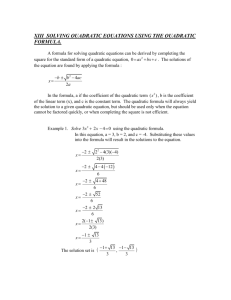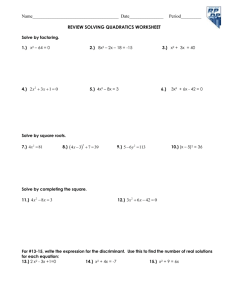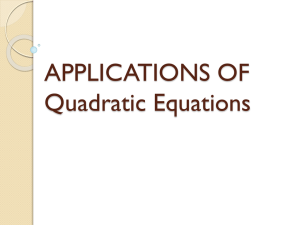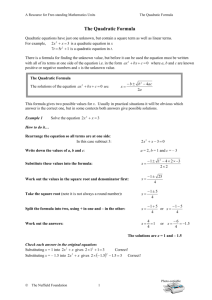1 Mathematical Prelude - University of Virginia
advertisement
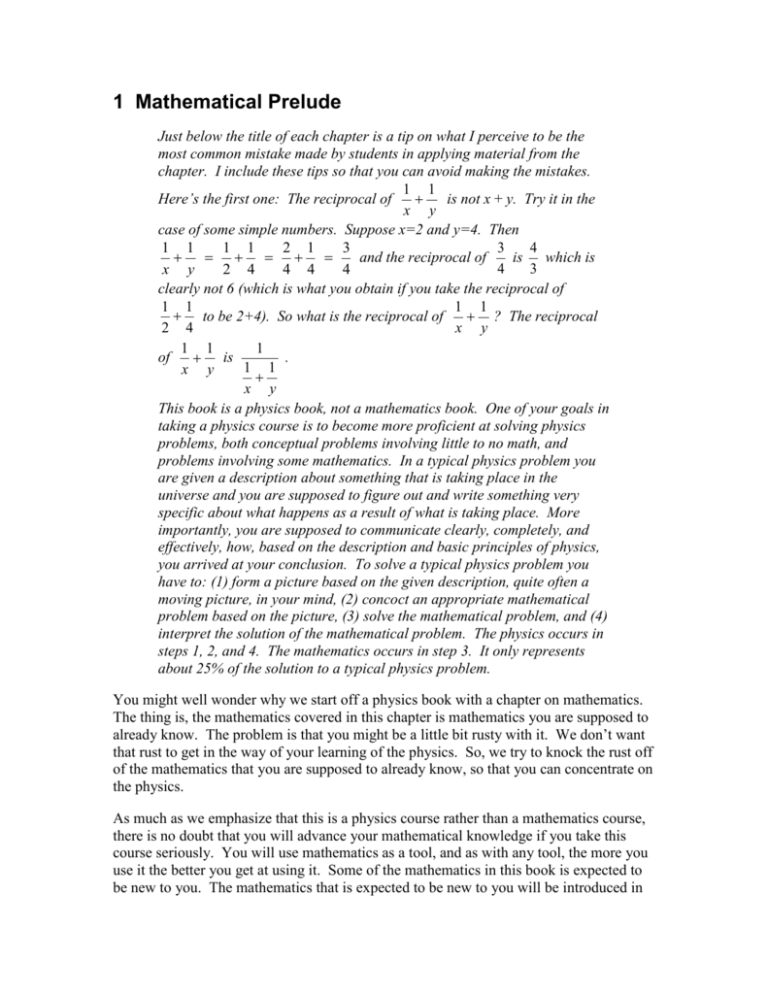
1 Mathematical Prelude Just below the title of each chapter is a tip on what I perceive to be the most common mistake made by students in applying material from the chapter. I include these tips so that you can avoid making the mistakes. 1 1 Here’s the first one: The reciprocal of is not x + y. Try it in the x y case of some simple numbers. Suppose x=2 and y=4. Then 3 4 1 1 1 1 2 1 3 and the reciprocal of is which is 4 3 x y 2 4 4 4 4 clearly not 6 (which is what you obtain if you take the reciprocal of 1 1 1 1 to be 2+4). So what is the reciprocal of ? The reciprocal 2 4 x y 1 1 1 of . is 1 1 x y x y This book is a physics book, not a mathematics book. One of your goals in taking a physics course is to become more proficient at solving physics problems, both conceptual problems involving little to no math, and problems involving some mathematics. In a typical physics problem you are given a description about something that is taking place in the universe and you are supposed to figure out and write something very specific about what happens as a result of what is taking place. More importantly, you are supposed to communicate clearly, completely, and effectively, how, based on the description and basic principles of physics, you arrived at your conclusion. To solve a typical physics problem you have to: (1) form a picture based on the given description, quite often a moving picture, in your mind, (2) concoct an appropriate mathematical problem based on the picture, (3) solve the mathematical problem, and (4) interpret the solution of the mathematical problem. The physics occurs in steps 1, 2, and 4. The mathematics occurs in step 3. It only represents about 25% of the solution to a typical physics problem. You might well wonder why we start off a physics book with a chapter on mathematics. The thing is, the mathematics covered in this chapter is mathematics you are supposed to already know. The problem is that you might be a little bit rusty with it. We don’t want that rust to get in the way of your learning of the physics. So, we try to knock the rust off of the mathematics that you are supposed to already know, so that you can concentrate on the physics. As much as we emphasize that this is a physics course rather than a mathematics course, there is no doubt that you will advance your mathematical knowledge if you take this course seriously. You will use mathematics as a tool, and as with any tool, the more you use it the better you get at using it. Some of the mathematics in this book is expected to be new to you. The mathematics that is expected to be new to you will be introduced in recitation on an as-needed basis. It is anticipated that you will learn and use some calculus in this course before you ever see it in a mathematics course. (This book is addressed most specifically to students who have never had a physics course before and have never had a calculus course before but are currently enrolled in a calculus course. If you have already taken calculus, physics, or both, then you have a well-earned advantage.) Two points of emphasis regarding the mathematical component of your solutions to physics problems that have a mathematical component are in order: (1) You are required to present a clear and complete analytical solution to each problem. This means that you will be manipulating symbols (letters) rather than numbers. (2) For any physical quantity, you are required to use the symbol which is conventionally used by physicists, and/or a symbol chosen to add clarity to your solution. In other words, it is not okay to use the symbol x to represent every unknown. Aside from the calculus, here are some of the kinds of mathematical problems you have to be able to solve: Problems Involving Percent Change A cart is traveling along a track. As it passes through a photogate1 its speed is measured to be 3.40 m/s. Later, at a second photogate, the speed of the cart is measured to be 3.52 m/s. Find the percent change in the speed of the cart. The percent change in anything is the change divided by the original, all times 100%. (I’ve emphasized the word “original” because the most common mistake in these kinds of problems is dividing the change by the wrong thing.) The change in a quantity is the new value minus the original value. (The most common mistake here is reversing the order. If you forget which way it goes, think of a simple problem for which you know the answer and see how you must arrange the new and original values to make it come out right. For instance, suppose you gained 2 kg over the summer. You know that the change in your mass is +2 kg. You can calculate the difference both ways—we’re talking trial and error with at most two trials. You’ll quickly find out that it is “the new value minus the original value” a.k.a. “final minus initial” that yields the correct value for the change.) Okay, now let’s solve the given problem 1 A photogate is a device that produces a beam of light, senses whether the beam is blocked, and typically sends a signal to a computer indicating whether the beam is blocked or not. When a cart passes through a photogate, it temporarily blocks the beam. The computer can measure the amount of time that the beam is blocked and use that and the known length of the cart to determine the speed of the cart as it passes through the photogate. % Change change 100 % original (1-1) Recalling that the change is the new value minus the original value we have % Change new original 100 % original (1-2) While it’s certainly okay to memorize this by accident because of familiarity with it, you should concentrate on being able to derive it using common sense (rather than working at memorizing it). Substituting the given values for the case at hand we obtain % Change 3.52 m m 3.40 s s 100% m 3.40 s % Change 3.5% Problems Involving Right Triangles Example 1-1: The length of the shorter side of a right triangle is x and the length of the hypotenuse is . Find the length of the longer side and find both of the angles, aside from the right angle, in the triangle. Solution: Draw the triangle such that it is obvious which side is the shorter side x y Pythagorean Theorem Subtract x 2 from both sides of the equation Swap sides Take the square root of both sides of the equation By definition, the sine of is the side opposite divided by the hypotenuse Take the arcsine of both sides of the equation in order to get by itself r 2 x2 y2 r 2 x2 y2 y2 r 2 x2 y r 2 x2 sin x sin 1 x By definition, the cosine of is the side adjacent to divided by the hypotenuse Take the arccosine of both sides of the equation in order to get by itself cos x cos 1 x Hypotenuse To solve a problem like the one above, you need to memorize the relations between the sides and the angles of a right triangle. A convenient mnemonic2 for doing so is “SOHCAHTOA” pronounced as a single word. Opposite Adjacent Referring to the diagram above right: SOH reminds us that: sin Opposite Hypotenuse (1-3) CAH reminds us that: cos Adjacent Hypotenuse (1-4) Opposite Adjacent (1-5) TOA reminds us that: tan Points to remember: 1. The angle is never the 90 degree angle. 2. The words “opposite” and “adjacent” designate sides relative to the angle. For instance, the cosine of is the length of the side adjacent to divided by the length of the hypotenuse. You also need to know about the arcsine and the arccosine functions to solve the example problem above. The arcsine function is the inverse of the sine function. The answer to the question, “What is the arcsine of 0.44?” is, “that angle whose sine is 0.44 .” There is an arcsine button on your calculator. It is typically labeled sin-1, to be read, “arcsine.” To use it you probably have to hit the inverse button or the second function button on your calculator first. 2 A mnemonic is something easy to remember that helps you remember something that is harder to remember. The inverse function of a function undoes what the function does. Thus: sin 1 sin (1-6) Furthermore, the sine function is the inverse function to the arcsine function and the cosine function is the inverse function to the arccosine function. For the former, this means that: sin sin 1 x x (1-7) Problems Involving the Quadratic Formula First comes the quadratic equation, then comes the quadratic formula. The quadratic formula is the solution to the quadratic equation: a x 2 bx c 0 (1-8) in which: x is the variable whose value is sought, and a, b, and c are constants The goal is to find the value of x that makes the left side 0. That value is given by the quadratic formula: x b b 2 4ac 2a to be read/said: ‘x’ equals minus ‘b’, plus-or-minus the square root of ‘b’ squared minus four ‘a’ ‘c’, all over two ‘a’. So, how do you know when you have to use the quadratic formula? There is a good chance that you need it when the square of the variable for which you are solving, appears in the equation you are solving. When that is the case, carry out the algebraic steps needed to arrange the terms as they are arranged in equation 1-8 above. If this is impossible, then the quadratic formula is not to be used. Note that in the quadratic equation you have a term with the variable to the second power, a term with the variable to the first power, and a term with the variable to the zeroth power (the constant term). If additional powers also appear, such as the one-half power (the square root), or the third power, then the quadratic formula does not apply. If the equation includes additional terms in which the variable whose value is sought appears as the argument of a special function such as the sine function or the exponential function, then the quadratic formula does not apply. Now suppose that there is a square term and you can get the equation that you are solving in the form of equation 1-8 above but that either b or c is zero. In such a case, you can use the quadratic formula, but it is overkill. If b in equation 1-8 above is zero then the equation reduces to a x 2 bx 0 The easy way to solve this problem is to recognize that there is at least one x in each term, and to factor the x out. This yields: (a x b) x 0 Then you have to realize that a product of two multiplicands is equal to zero if either multiplicand is equal to zero. Thus, setting either multiplicand equal to zero and solving (1-9) for x yields a solution. We have two multiplicands involving x, so, there are two solutions to the equation. The second multiplicand in the expression (a x b) x 0 is x itself, so x=0 is a solution to the equation. Setting the first term equal to zero gives: ax b 0 a x b x b a Now suppose the b in the quadratic equation a x 2 bx c 0 , equation 1-8, is zero. In that case, the quadratic equation reduces to: a x2 c 0 which can easily be solved without the quadratic formula as follows: a x 2 c x2 c a x c a where we have emphasized the fact that there are two square roots to every value by placing a plus-or-minus sign in front of the radical. Now, if upon arranging the given equation in the form of the quadratic equation (equation 1-8): a x 2 bx c 0 you find that a, b, and c are all non-zero, then you should use the quadratic formula. Here we present an example of a problem whose solution involves the quadratic formula: Example 1-2: Quadratic Formula Example Problem Given 3 x 24 x 1 find x. At first glance, this one doesn’t look like a quadratic equation, but as we begin isolating x, as we always strive to do in solving for x, (hey, once we have x all by itself on the left side of the equation, with no x on the right side of the equation, we have indeed solved for x—that’s what it means to solve for x) we quickly find that it is a quadratic equation. Whenever we have the unknown in the denominator of a fraction, the first step in isolating that unknown is to multiply both sides of the equation by the denominator. In the case at hand, this yields ( x 1) (3 x) 24 Multiplying through on the left we find 3 x 3 x 2 x 24 At this point it is pretty clear that we are dealing with a quadratic equation so our goal becomes getting it into the standard form of the quadratic equation, the form of equation 1-8, namely: ax 2 bx c 0 . Combining the terms involving x on the left and rearranging we obtain x 2 4 x 3 24 Subtracting 24 from both sides yields x 2 4 x 21 0 which is indeed in the standard quadratic equation form. Now we just have to use inspection to identify which values in our given equation are the a, b, and c that appear in the standard quadratic equation (equation 1-8) ax 2 bx c 0 . Although it is not written, the constant multiplying the x2, in the case at hand, is just 1. So we have a = 1, b = 4, and c = 21. Substituting these values into the quadratic formula (equation 1-9): x b b 2 4ac 2a yields x which results in 4 4 2 4(1)( 21) 2(1) (1-10) x 3 , x 7 as the solutions to the problem. As a quick check we substitute each of these values back into the original equation, equation 1-10: 24 3 x x 1 and find that each substitution leads to an identity. (An identity is an equation whose validity is trivially obvious, such as 6 = 6.) This chapter does not cover all the non-calculus mathematics you will encounter in this course. I’ve kept the chapter short so that you will have time to read it all. If you master the concepts in this chapter (or re-master them if you already mastered them in high school) you will be on your way to mastering all the non-calculus mathematics you need for this course. Regarding reading it all: By the time you complete your physics course, you are supposed to have read this book from cover to cover. Reading physics material that is new to you is supposed to be slow going. By the word reading in this context, we really mean reading with understanding. Reading a physics text involves not only reading but taking the time to make sense of diagrams, taking the time to make sense of mathematical developments, and taking the time to make sense of the words themselves. It involves rereading. The method I use is to push my way through a chapter once, all the way through at a novel-reading pace, picking up as much as I can on the way but not allowing myself to slow down. Then, I really read it. On the second time through I pause and ponder, study diagrams, and ponder over phrases, looking up words in the dictionary and working through examples with pencil and paper as I go. I try not to go on to the next paragraph until I really understand what is being said in the paragraph at hand. That first read, while of little value all by itself, is of great benefit in answering the question, “Where is the author going with this?”, while I am carrying out the second read.





